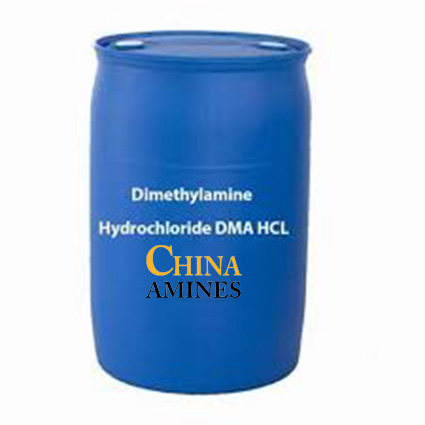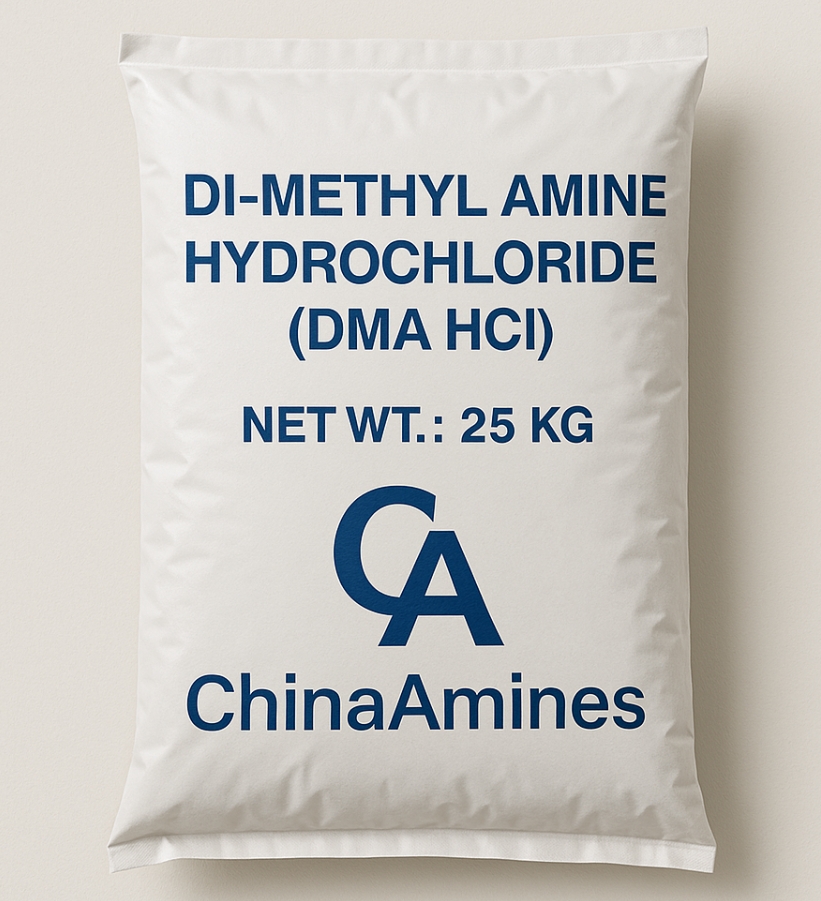1. Chemical Structure and Properties
Molecular Formula: C₂H₈ClN
Structural Formula: (CH₃)₂NH·HCl
A secondary amine hydrochloride formed by neutralizing dimethylamine with hydrochloric acid.
Physical Properties:
Appearance: White crystalline powder or hygroscopic solid.
Melting Point: 170–175°C (decomposes without melting).
Solubility: Highly soluble in water (>500 g/L at 25°C), ethanol, methanol; insoluble in non-polar solvents.
Odor: Odorless, unlike volatile DMA gas.
Hygroscopic: Absorbs moisture rapidly, requiring airtight storage.
Chemical Properties:
Stability: Stable under dry conditions; decomposes on heating to release DMA gas and HCl.
Reactivity: Weak acid in aqueous media (pKa ≈ 10.7); reacts with strong bases to regenerate DMA.
2. Industrial Applications
Pharmaceuticals:
- Intermediate: Key building block for antihistamines (e.g., diphenhydramine) and antidepressants (e.g., fluoxetine).
- Salt Formation: Enhances solubility and stability of APIs (e.g., lidocaine hydrochloride).
Agrochemicals:
- Herbicides: Used in the synthesis of glyphosate (e.g., Monsanto’s Roundup®).
- Insecticides: Precursor in the production of neonicotinoids (e.g., imidacloprid).
Organic Synthesis:
- Catalyst/Reagent: Used in alkylation and Mannich-type reactions.
- Polymers: Stabilizer for epoxy curing agents and polyurethanes.
Laboratory Use:
- pH adjuster and buffering agent in biochemical applications.
3. Safety and Toxicology
Health Hazards:
- Limited data on liver/kidney toxicity; not classified as carcinogenic (IARC: Not listed).
- Skin/Eye Contact: Causes irritation or burns (rabbit skin LD50: 500 mg/kg).
- Inhalation: Irritating if inhaled as dust or vapor (e.g., DMA release on decomposition).
- Ingestion: Moderately toxic (oral LD50 rat: ~1,200 mg/kg); may cause gastrointestinal upset.
Handling Precautions:
- PPE: Use nitrile gloves, safety goggles, and N95 respirators.
- Storage: Store in airtight containers in a cool, dry environment; avoid contact with strong bases.
- First Aid: Rinse affected areas with water; seek medical attention if necessary.
4. Environmental and Regulatory Compliance
Environmental Impact:
- Aquatic Toxicity: LC50 (fish, 96h): 100–200 mg/L; EC50 (daphnia): 50–100 mg/L.
- Biodegradability: Readily biodegradable (OECD 301D: >70% in 28 days).
- Persistence: Decomposes rapidly in water via hydrolysis.
Regulatory Frameworks:
- GB 13690-2009: Classified as a general hazardous chemical (non-flammable).
- OSHA: No specific PEL; general dust control applies.
- EPA: Listed under TSCA Inventory.
- CLP Regulation (EU): Skin Irrit. 2 (H315), Eye Irrit. 2 (H319), Acute Tox. 4 (H302).
- REACH: Registered substance; SDS required for industrial handling.
Transport:
- UN Number: Not classified as hazardous; shipped as non-dangerous goods (non-DG).
5. Case Studies and Application Insights
Case 1: Diphenhydramine Synthesis
- Process: DMA HCl reacts with diphenylmethane derivatives to yield diphenhydramine hydrochloride (Benadryl®).
- Efficiency: 92% yield under mild, scalable conditions (Pfizer-developed process).
Case 2: Glyphosate Production
- Application: DMA HCl is used in the phosphonomethylation of glycine to form glyphosate.
- Advantage: Solid form improves safety and handling compared to volatile DMA gas.
Comparative Analysis:
- Pros: Safer solid form; stable, easy to store and handle.
- Cons: Requires regeneration (basification) to obtain free amine in reactions.



